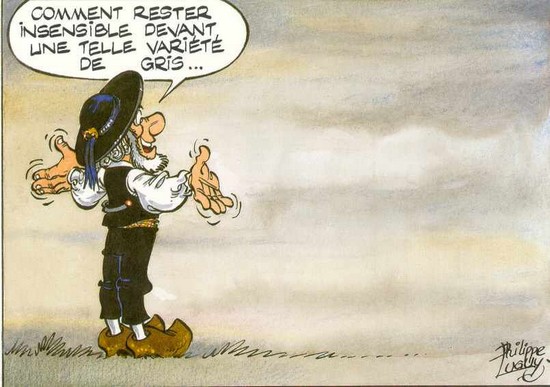Colours in French : names, nuances, and grammar
Learning French colours is an easy and useful step to take for any learner of the language. Let’s learn how to express colours in French and their nuances, in a lot of meaningful ways. We’ll deepen our study a little bit further than the usual list of main colours that’s all over the web ; and we’ll take a few grammar considerations too. Let’s go !
The main colours in French
We’ll start by the most basic question, the one that might have actually brought you to this page anyways : How do you say the colours in French ? After all, learning a new language is also about memorizing vocabulary, and we might as well start with our exploration of French colours with a little list.
| Colour in French | Colour in English |
| Rouge | Red |
| Vert | Green |
| Bleu | Blue |
| Jaune | Yellow |
| Orange / Orangé | Orange |
| Violet | Violet |
| Rose | Rose |
| Marron | Maroon |
| Gris | Gray |
| Noir | Black |
| Beige | Beige |
| Blanc | White |
| Mauve |
Raspberry |
| Ocre | Ocre |
| Indigo | Indigo |
| Pourpre | Purple |
| Cyan | Cyan |
| Magenta | Magenta |
| Turquoise | Turquoise |
| Or / Doré | Golden |
| Argent / Argenté | Silver |
Examples :
- Cette voiture est rouge. (this car is red.)
- Les ours ont généralement le poil marron. (Bears generally have brown fur.)
A few possible variations
Sometimes, the colour isn’t marked very much, or it’s almost not that colour. You can express this in French by adding a special ending in -âtre (only for these ones) :
| Colour in French | Colour in English |
| Rougeâtre | Reddish |
| Jaunâtre | Yellowish |
| Verdâtre | Greenish |
| Bleuâtre | Blueish |
| Orangeâtre | – |
| Noirâtre | Blackish |
| Blanchâtre | Whitish |
Example :
- Les algues donnent au rochers une couleur verdâtre. (The algaes gave thse rocks a greenish colour.)
Also, if you want to want to describe a colour that’s between two other colours, or if you’re not really sure if it’s one or the others, you can make a new word by joining the two of them with a hyphen : rouge-orangé, bleu-gris, marron-jaune, bleu-argenté, jaune-doré, vert-rougeâtre…
- Je ne sais pas top si cette couleur est plutôt vert-bleu ou bleu-vert. (I don’t know if this colour is blue-green or green-blue.)
A lot of colours in French have a special name derived from something of this colour :
| Colour in French | Colour in English |
| Bleu marine | Navy blue |
| Bleu ciel | Sky blue |
| Vert pomme | Apple green |
| Vert feuille | Leaf green |
| Rouge sang | Blood red |
Example :
- J’ai fait repeindre ma voiture en vert anis. (I had my car painted anis green.)
Grammatically, this is an elision : what you describe is something bleu [comme le] ciel (blue as the sky) or un bleu [de la couleur du] ciel (a blue of the colour of the sky). Some expressions, like the ones above, are widely used and have a standard name, but if you have your own poetic mind and you want to transmit the impression of a colour in your own way, there is no limitation but the pertinence of your comparison (well, if you‘re saying vert-soleil, you’ll be looked at a bit weirdly, won’t you?).
Be imaginative !
- jaune marguerite (marygold yellow)
- rouge ketchup
- jaune pipi (piss yellow)
- jaune “fromage fondu” (melted-cheese yellow)
Note that an expression like this may transmit a little more than just the colour. Consider for example that it would make little sense (or maybe only with the intention of derision or dramatization) to use rouge sang instead of rouge pizza (and vice-versa) in these two sentences, although it is the same colour :
- Après la bataille, la colline était rouge sang. (After the battle, the hill was blood red.)
- Jean avait renversé son assiette, le sol était rouge pizza. (Jean had dropped his plate, the ground was pizza red.)
Sometimes, you’ll find bigger elisions as the name of the colour itself is also omitted.
- une fleur soleil = une fleur [jaune comme le] soleil (a flower yellow like the sun)
- Passe moi le crayon aubergine, s’il te plait. (Pass me the aubergine crayon, please.)
Although generally you would express this with the word couleur :
- une fleur couleur soleil
- une fleur de la couleur du soleil
One last construction that you’ll most probably will hear from times to times : with the preposition de followed by a the name of something that has this characteristic colour :
- des cheveux d’un noir de jais et des yeux d’un vert d’émeraude.
- or simply : des cheveux de jais et des yeux d’émeraude.
- un vert d’herbe naissante (a green of newly grown herb)
How to express nuances of colours in French
When we express colours in French, like we would do in English, we often express nuances by adding a qualitative. Here is a list of the main ones :
| In French | In English |
| Clair | Light |
| Foncé, sombre | Dark |
| Délavé | Washed |
| Pastel | Pastel |
| Vif | Bright |
| Saturé | Saturated |
| Terne | Tern |
| Pâle | Pale |
| Doux | soft |
| Fort | Strong |
| Mat | Mate |
| Brillant | Shiny |
| Satiné | Satined |
| Metalisé | Metalized |
| Chromé | Chrome |
| Irisé | Irised |
| Fluorescent (fluo) | Fluorescent |
| Phosphorescent | Phosphorescent |
Examples :
- Sa voiture est gris métalisé. (His car was metalized gray.)
- Le plumage irisé du colibri est magnifique. (The irised robe of the hummingbird is beautiful.)
- Elle a les cheveux d’un noir mat et la peau brun clair. (She has a mate black hair and light brown skin.)
Wait, seriously, about the hummingbird : it’s incredibly beautiful. You need to see this.
Relations between colours
There are also a lot of words that express relations between colours in French.
| In French | In English |
| La couleur dominante, ou principale | The main / dominant colour |
| Une touche de vert / Une pointe de vert | A touch of green |
| La couleur de fond | The backgroud colour |
| Le contraste entre deux couleurs des couleurs contrastées |
The contrast between two colours contrasting colours |
| Des couleurs proches ou éloignées | Close or different colours |
| Des couleurs complémentaires | Complementary colours |
| Un dégradé entre deux couleurs | A gradient between two colours |
| Un mélange entre deux couleurs | A mixture of two colours |
Examples :
- Un dégradé du vert pomme au bleu ciel. (a gradient from apple green to sky blue.)
- Le vert de la feuille contraste beaucoup avec le rouge du fruit. (The green of the leaf contrasts a lot with the red of the fruit.)
- Le peintre mélange le bleu et le jaune pour faire du vert. (The painter mixes blue and yellow to make green.)
A little bit of grammar
You may know that in French, adjectives must agree with the noun they accompany : in gender (masculine or feminine) as well as in number (singular or plural). Well, Same goes for the adjectives describing colours, that we discovered at the beginning of this article :
rouge, vert, bleu, jaune, violet, rose, noir, blanc, gris, pourpre, argenté, doré…
- Un chat noir (a black cat, male)
- Une chatte noire (female)
- Des chats noirs (males)
- Des chattes noires (females)
So far so good. But when the colour is named after a mineral, a vegetal, etc… Then it’s invariable. This is due to the fact that it is actually an elision :
orange, marron, champagne, cerise, prune, émeraude, rubis,
- des pulls orange = des pulls [de la couleur de l’] orange
(pullovers [the colour of an] orange)
In the case of rose, écarlate, vermeil, violet and a few more, they have ascquired the status of a simple adjective over time, which explains that they behave differently although they are names of vegetals.
And when a colour is expressed by two or more words, all the words are invariable :
- une voiture grise, but ; des voitures gris métalisé
- des orchidées jaune foncé
- des chaussures bleu marine
Did you know ?
In the region of France where I live, La Bretagne, the culture and language from before the unification of France by Napoléon is still very present. Out of personal curiosity, I took one year of lessons to learn Breton. An interesting fact I learnt : in Breton, the word glaz means both blue… and green. It’s the colour of the sea, of what’s alive. Of the leaves, of algaes. There is another word for green, gwar, that is used for all other types of inanimate greens : paintings, glass bottles…
How interesting is it that the way a nation sees the world is reflected in its language ?
C’est tout, les amis !
There is so much to say about colours, and I’ll make another post to talk a little bit about colorimetry. Stay tuned, and until then, if you have any question about the colours in French, I’ll answer in the comments !




Leave a Reply
Want to join the discussion?Feel free to contribute!